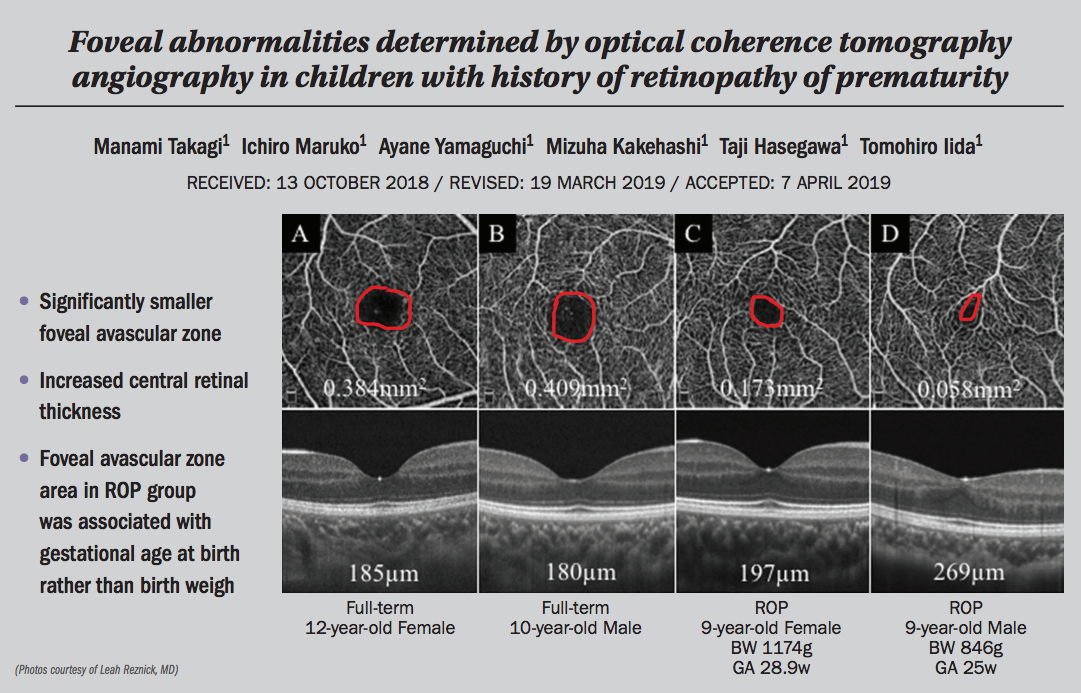News
Article
OCTA a hope for diagnosing, managing ophthalmic diseases
Author(s):

Technologies can help ophthalmologists treat challenging cases in young patients
This article was reviewed by Leah Reznick, MD
Optical coherence tomography angiography (OCTA) may have a bright future in the care of pediatric patients with retinopathy of prematurity (ROP), amblyopia, and glaucoma, offering an increased understanding of disease pathophysiology and aiding in disease diagnosis and management.
OCTA is rapid and noninvasive technology that is advantageous for evaluating the complete microvascular (superficial and deep and choroidal microvasculature) in children. The images obtained are high-resolution, three-dimensional and cross-sectional images with quantifiable metrics. The downsides are the significant artifacts created by motion.
Fluorescein angiography (FA) and indocyanine green angiography (ICGA), both of which require dye injections, provide a wide field of view in contrast to the 30-degree field of view of OCTA and are better suited for evaluating ROP and low-flow vascular lesions. FA and ICGA are limited to visualizing superficial retinal circulation and choroidal vasculature, respectively.
Both types of imaging currently have their place for certain populations and diseases, according to Leah Reznick, MD, associate professor, Casey Eye Institute, Oregon Health Sciences University, Portland.
OCTA option
Recent research has indicated the OCTA may be useful to manage ROP and provide a better understanding of how the disease affects the retinal anatomy later in the lives of affected children. OCTA was evaluated fairly recently in babies.
In one study, OCTA visualized hyperreflectivity that corresponded to recurrent extraretinal superficial and deep neovascularization seen on FA in a baby with type 1 ROP after laser treatment who required additional laser (J AAPOS 2016;20:271-4). Another study used a prototype swept-source (SS) OCTA that had been integrated into the operating room microscope and reported the first data from OCTA acquired intraoperatively in two patients (JAMA Ophthalmol 2017;135:483–6).
“Neither method is practical for widespread use in ROP screening and diagnosis, but it demonstrates the potential of OCTA for assisting in the diagnosis and management of ROP,” said Dr. Reznick.
According to Dr. Reznick, investigators at the Casey Eye Institute have developed a prototype handheld OCTA SS-OCT/OCTA for use in patients with ROP (JAMA Ophthalmol 2017;135: 977–81).
“This technology has generated images that provide objective evaluation of ROP zone, stage, and plus disease,” she said. “This handheld device is designed to provide a wider field of view from 40 degrees up to 100 degrees using a contact lens-based approach.”
Dr. Reznick explained that the researchers, led by J. Peter Campbell, MD, MPH, achieved the wider field of view by adjusting the scanning pattern and tolerating some motion artifact. This technology demonstrates widespread perfusion into zone II and clinicians can see the corresponding retinal structure on OCT.
Another advantage of OCTA is that it can better detect neovascularization than can be accomplished during a clinical examination.
Dr. Reznick described the case of a baby treated with bevacizumab (Avastin, Genentech Inc.) for zone I stage 3 ROP in which the disease appeared on the surface to be clinically regressed; however, OCTA showed in cross-sectional images that there was residual flow above the internal limiting membrane near the border of the perfused and non-perfused retina.
The technology also can identify extraretinal neovascularization and monitor for disease recurrence. “In this way, OCTA can help diagnostically and determine future treatment,” she noted.
The technology also can provide a look at the foveas in children with a history of ROP compared with those without ROP. A study published in Eye (Lond) (2019;33:1890-6) reported that 80% of subjects had been treated for ROP and had significantly smaller foveal avascular zones, increased central retinal thickness, and the foveal avascular zone area in the ROP group was associated with gestational age at birth and not birth weight.
OCTA in amblyopia
A review of the literature showed that the research has focused on the size of the foveal avascular zone and the density of the superficial and deep capillary plexi to identify anatomic differences in eyes with amblyopia.
Small studies have recently reported some mixed results stemming from the different types of amblyopia.
“Most studies showed no difference in the size of the foveal avascular zone; however, a majority of the studies showed a decreased density of the superficial and deep capillary plexi in patients with amblyopia,” she said.
The research suggested some areas for future study, namely, that there needs to be larger scale and prospective studies looking at the retinal microvasculature and foveal avascular zone of anisometropic and strabismic amblyopes to generalize this information and determine its clinical applicability.
Dr. Renick noted that it also raises the interesting question about whether the vascular changes are the cause or the effect of amblyopia.
OCTA and pediatric glaucoma
Does pediatric glaucoma work the same way as adult glaucoma?
Dr. Reznick noted that in adults blood flow in the peripapillary microvasculature is lost and that decreased blood flow is correlated with visual field loss.
A study performed at the Casey Eye Institute compared the vascular density in children with juvenile open-angle glaucoma (OAG) with healthy controls using OCTA.
The investigators reported that juvenile OAG patients have decreased peripapillary and macular perfusion (J AAPOS doi: https://doi.org/10.1016/j.jaapos.2019.08.160).
Dr. Reznick also point out that from this initial study, researchers have learned that OCTA use in children is feasible and its use is encouraging as a non-invasive diagnostic tool in children with glaucoma.
“OCT and OCTA have changed the way we care for adults with a variety of retinal diseases and glaucoma,” she said. ‘For pediatric patients with ROP, amblyopia, and glaucoma, OCTA will help us understand underlying pathophysiology and aid in diagnosis and management of disease. We are in the infancy stage of understanding the applications of OCTA, and significantly more research needs to be performed to understand and validate its applications.”
Leah Reznick, MD
E: reznick@ohsu.edu
Dr. Reznick has no financial relationships relevant to this report.
Newsletter
Don’t miss out—get Ophthalmology Times updates on the latest clinical advancements and expert interviews, straight to your inbox.





